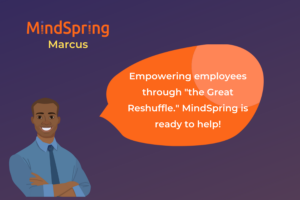Sick of the Great Resignation? Here’s How to Navigate the Candidate Market in 2022
by MindSpring Marcus on January 20, 2022 in MindSpring Marcus

Hey there – Marcus here!
If you’re anything like me, you’re already sick of hearing about the Great Resignation. I also recently heard the term “the Great Reshuffle,” the general shift in employee attitudes about the hows and whys of work itself. Super fascinating topics, but when it comes to actually navigating these issues IRL, it’s overwhelming to say the least.
As I’ve mentioned before, I’m responsible for leading my company’s IT team, and since the pandemic hit, we’ve needed more staff than ever to help manage our network. MindSpring has been a huge help in finding and hiring the right talent (check out my previous post on this topic from a while back). But this whole “great resignation” thing really turns things upside down.
As you probably know and have seen, there are record numbers of people quitting their jobs—and they’re not leaving because of bad bosses or stressful environments (though that’s certainly happening too)—they’re quitting because more appealing opportunities are at hand. Bigger paychecks! Better benefits! Fancy sign-on bonuses! Sign me up, amiright?!
But unemployment is also impressively low, and the professional and business sector has apparently recaptured almost all of the jobs that were lost in the early pandemic. And with an ever-increasing number of jobs being added to our economy, it all adds up to an incredibly competitive market and, well, a slightly chaotic time to try to hire.
Fortunately, as always, MindSpring has been right here, checking in and keeping a pulse on the market for me. I recently chatted with Ty, Senior Recruiter at MindSpring, about the best way to cut through the chaos and make the most of the current candidate market. Let me share a few of their insights.
Understand What Candidates Are Looking for
In such a competitive market, Ty reminded me how important it is to tune into what candidates are looking for in their next roles. Even if they’re contractors rather than full-time employees, they have plenty of room to be picky in a market where they could get five different job offers in the space of a week.
MindSpring is talking with hundreds of contractors and full-time workers across industries every day, so they have a good sense of what people are looking for right now.
Money, of course, remains one of the most important factors. Inflation is through the roof (ugh) and every company knows that money talks loudest in a competitive market. Partnering with a firm like MindSpring has been helpful because they have more insight into specific salary trends so I can make more data-driven decisions.
But money isn’t everything. The pandemic forced many employers, my own included, to be more flexible—and many of us discovered that this is what we’ve wanted all along. Remote and hybrid models, flexible work schedules, redesigned processes, workplaces, and cultures are just a handful of strategies to help people perform at their optimal levels.
And, finally, perks never hurt, right? A home office stipend, on-site childcare, gym memberships, free lunches, you name it – Ty says he’s seen it all. The point is, find out what your candidates truly value and do what you can to cater to them. In a tight candidate market, this strategy can help open up the talent pool to a wider range of qualified candidates who are interested in what you have to offer.
Re-evaluate Your Job Requirements
I’ve heard Ty say this pre-pandemic, but it seems even more important in the current candidate market: employers often need to be more flexible in their job requirements than they’re willing to admit.
Tech is a great example. For years, companies required some kind of degree to even consider a candidate. But the IT industry is no stranger to competitive candidate markets, and many companies have recognized that the skills they need are often gained with or without a degree, thanks to online bootcamps and courses and even good old DIY learning.
Sometimes the exact level of required experiences ends up somewhat arbitrary. Other times, certain skills can be trained on-the-job. Often, experience or skillsets you may not have considered will translate well into the ones you actually need, and the right candidates can easily get up to speed.
Ty has helped me fine-tune my own job descriptions, and I’ve seen a wider talent pool as a result.
Practice Empathy and Transparency
That “Great Reshuffle” I mentioned above? It was a term coined by LinkedIn’s CEO Ryan Roslansky, when he said in an interview with Time Magazine: “You have employees globally who are rethinking not just how they work, but why they work and what they most want to do with their careers and lives.” In short, the pandemic forced us all to start asking bigger questions about what we really want in life.
Because of this, Ty believes that the more empathic, transparent, and trustworthy a company is, the more successful they’ll be in navigating this shift. LinkedIn’s VP of Product Management for Talent Solutions, Hari Srinivasan, says that an open dialogue between employers and employees is key. People want to know they’re being heard and that their best interests are top of mind.
But, as Ty reminded me, this dialogue starts well before someone is an active employee—it starts in the hiring process. I know that both my company and I are creating an impression on potential candidates with every LinkedIn post, webpage, email, and voicemail. Interviews are two-way streets, where the candidate is evaluating me as an employer just as much as I’m evaluating them as an employee. (And, hey, if you’re working with a recruiter the way I’m working with MindSpring, you’ve got to remember that they are part of the impression you’re creating, too—make sure you’re partnering with a firm that makes sense for you!)
Ultimately, when more and more people are questioning their bigger purpose in their lives and careers, you need to be an employer who is willing and able to help them with satisfactory answers. It’s a challenge, but I’m up for it – are you?
Struggling to find and hire top talent for your team? MindSpring is ready to help! Contact us to get started today.
Related Articles
3 Reasons Your Business Should Be Partnering with a Staffing Firm
The Do’s and Don’ts of Engaging Remote Employees
How to Retain Top Talent Throughout the COVID-19 Pandemic


